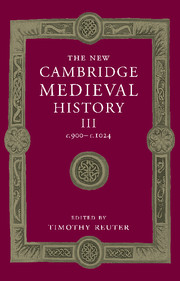Book contents
- Frontmatter
- 1 Introduction: reading the tenth century
- PART I GENERAL THEMES
- PART II POST-CAROLINGIAN EUROPE
- 9 The Ottonians as kings and emperors
- 10 Saxony and the Elbe Slavs in the tenth century
- 11 Bavaria in the tenth and early eleventh centuries
- 12 Lotharingia
- 13 Burgundy and Provence, 879–1032
- 14 The kingdom of Italy
- 15 West Francia: the kingdom
- 16 West Francia: the northern principalities
- 17 Western Francia: the southern principalities
- 18 England, c. 900–1016
- PART III NON-CAROLINGIAN EUROPE
- Appendix genealogical tables
- List of primary sources
- Bibliography of secondary works arranged by chapter
- Index
- Frontispiece
- Plate section
- Map 2: Archbishoprics and bishoprics in the early eleventh century
- Map 4: Germany
- Map 13: Byzantium in 1025
- References
12 - Lotharingia
from PART II - POST-CAROLINGIAN EUROPE
Published online by Cambridge University Press: 28 March 2008
- Frontmatter
- 1 Introduction: reading the tenth century
- PART I GENERAL THEMES
- PART II POST-CAROLINGIAN EUROPE
- 9 The Ottonians as kings and emperors
- 10 Saxony and the Elbe Slavs in the tenth century
- 11 Bavaria in the tenth and early eleventh centuries
- 12 Lotharingia
- 13 Burgundy and Provence, 879–1032
- 14 The kingdom of Italy
- 15 West Francia: the kingdom
- 16 West Francia: the northern principalities
- 17 Western Francia: the southern principalities
- 18 England, c. 900–1016
- PART III NON-CAROLINGIAN EUROPE
- Appendix genealogical tables
- List of primary sources
- Bibliography of secondary works arranged by chapter
- Index
- Frontispiece
- Plate section
- Map 2: Archbishoprics and bishoprics in the early eleventh century
- Map 4: Germany
- Map 13: Byzantium in 1025
- References
Summary
from 900 to 939
The kingdom held by Zwentibald, who died on 13 August 900, became a duchy with the same boundaries, known from the start by the convenient designation of Lotharingia. The borders were delineated by Frisia and the North Sea in the north and by Burgundy in the south, along the line where the diocese of Toul met the dioceses of Besançon and Langres. As far as the borders with the kingdom of west Francia and the neighbouring Germanic duchies are concerned, matters are less clear. One must concede that the ancient principle of boundaries defined by major rivers, as followed in the partition of Verdun in 843, still remained essentially valid: thus the Meuse and the Scheldt in the west and the Rhine in the east were in theory the borders of Lotharingia in this period. The reality was rather more complex. In the absence of other administrative units with precise borders it was the dioceses which counted, and their bishops were dependent on the ruler of east Francia. If in the west one traces the western bounds of the dioceses of Toul and Verdun, one finds that these extended some way to the west, beyond the left bank of the Meuse, and it must be asked whether the pagi on the left bank within these dioceses were subject to the authority of the king of west Francia or not, a question which applies in particular to the Ornois and the Barrois, thus for the Lingonian part of the Bassigny. Traditionally, the three eastern pagi of the diocese of Rheims – Astenois, Dormois and Castrice – were held to be ‘imperial’. Given such uncertainty, and given also the slow evolution characteristic of the tenth century, it should probably be said that the rulers regarded the Meuse as a boundary, but that the authority of the east Frankish kingdom extended some way to the west of this river.
Keywords
- Type
- Chapter
- Information
- The New Cambridge Medieval History , pp. 310 - 327Publisher: Cambridge University PressPrint publication year: 2000
References
- 1
- Cited by

